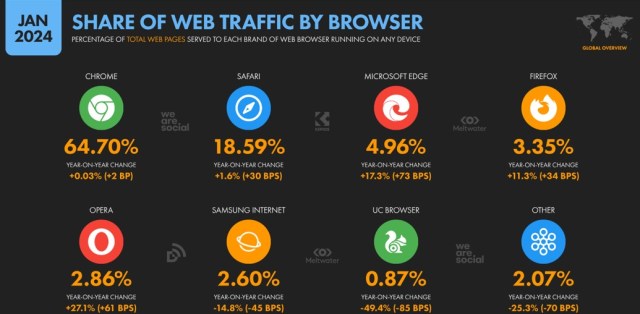We don’t realise it, but nowadays, the web browser is one of the most widely used digital tools for all users. It facilitates access to the internet and is essential for surfing the web. The history of web browsers can be summarised as a silent evolution over time.
What is a web browser?
A web browser is software that allows you to access the internet, search and view information, work and access all kinds of services, through a connection to the internet. Through the use of the Hypertext Transfer Protocol, HTTP, this information, i.e. images, text and videos, is shared and displayed in a format that can be viewed in any browser.
Browsers receive the data from the servers and interpret it into HTML code, the universal language used by programmers to design websites. In this way, the content is presented on the screen of the device used (computer, tablet or smartphone), so that the user can continue browsing the World Wide Web.
There are currently several web browsers, and each of them has its own history and special techniques that differentiate them from the rest. However, the web standards published by the W3C, the world organisation in charge of developing web protocols, allow the information on each web page to be adapted to be visible in all browsers, even if in different ways.
History of early browsers
Browsers are applications that make it easier for users to interact with the internet, they are like a large collection of hypertexts, and their history is linked to the WWW.
The beginnings of ancient browsers date back to the time when Tim Berners-Lee, a hypertext computer scientist, created the first web server and browser, called the World Wide Web, while working at CERN in the late 1990s. Although it was quite sophisticated and graphical for the time, it only worked on workstations at NeXT Computer Inc, a company founded by Steve Jobs. Although it was an innovation, browsers did not really catch on at the time.
- Mosaic. In 1993, with the advent of the Internet in governments, universities and large corporations, Mosaic, the second graphical web browser available for websites, was born. It was created at the National Center for Supercomputing Applications (NCSA) at the University of Illinois Urbana-Champaign and designed by Marc Andreessen. Initially, it only ran on Unix workstations and was developed for the Microsoft Windows system, but it has been considered the first browser with relevance, as the NCSA later developed adaptive versions for both Windows and Macintosh.
- Netscape Navigator. In 1994 came Netscape Navigator, the first commercial web browser created by the company Netscape Communications. It was completely free for all non-commercial users. This development marked the beginning of the competitive struggle between browsers, a struggle marked, above all, by Microsoft and Netscape. In 1997 the company launched Netscape Navigator 2.0, the first browser with Java script language on web pages.
- Opera. The Norwegian company Opera Software created this browser in 1994. It has been free to use since the release of version 8.50. It has been recognised for its speed, security and standardisation, and has a constantly evolving international language. It is compatible with Microsoft Windows, Mac OSX and GNU/Linux operating systems, among others.
- Internet Explorer. The Internet Explorer (IE) web browser was developed by Microsoft Windows in 1995. In the late 1990s and early 2000s, it became the most popular browser. According to the technology company, it reached usage rates of 95 % between 2002 and 2003. However, its popularity declined over the years, as competitors developed browsers with a renewed aesthetic, such as Google Chrome.
- Google Chrome. Chrome is a must in the history of browsers and was developed by Google in 2008. It is made up of complex open source components and infrastructure, such as the Blink rendering engine, and according to the company, it is the most widely used browser in the world, with some 3.4 billion users. With this browser, users can synchronise bookmarks and adjust all their devices, use specific products and obtain personalised results when entering text.
- Mozilla. It was created by Dave Hyatt and Blake Ross as a computer test, and takes Mosaic as its direct ancestor. The first version was released on 9 November 2004. It progressively advanced to become one of the most widely used Internet browsers, with a worldwide usage share of around 30 %, according to official company sources. The browser has been very popular in Germany and Poland, with a usage rate of 60 % and 47 % respectively.
- Safari. This browser is installed by default on Apple’s connected devices and was launched on 7 January 2003. According to its developers, it is the most stable and advanced of all, and consumes less battery power than Chrome and Mozilla, its main competitors. It is completely free and has security add-ons that offer private browsing.
Browser usage: the most used browsers of 2024 worldwide
Global Internet users will reach 5.35 billion in 2024, 66.2% of the world’s population. With respect to 2023, 97 million people have increased, which represents a 1.8% increase, according to data from the Digital 2024 report.
According to the figures of the same study, we can extract which are the most used browsers at present:
- Chrome leads, by far, this ranking. Practically two out of every three searches are made through Google’s browser, specifically 64.7%. A leadership position it has climbed to since 2013, when the percentage was 35.8%.
- Safari occupies the second position with almost one in five users of the total number of browsers. Specifically, 18.59% of the total and with a growth of 1.6% compared to the previous year.
- The podium is completed by Microsoft Edge, successor to Internet Explorer, with 4.98% and a high increase of 17.3% over the previous year.
- In fourth position is Firefox, from the Mozilla Foundation, which after a rise of 11.3% reaches 3.35% of usage.
- Slightly behind is Opera, with 2.86%, although with a significant increase of 27.1%.
- Behind it, Samsung Internet is at 2.60%, with an accumulated decline of 14.8%.
- Finally, the study includes data from UC Browser, which has a 0.87% share after a drop of 49.4%.
- Other browsers account for 2.07% of the total, although with a decrease of more than 25% overall.












